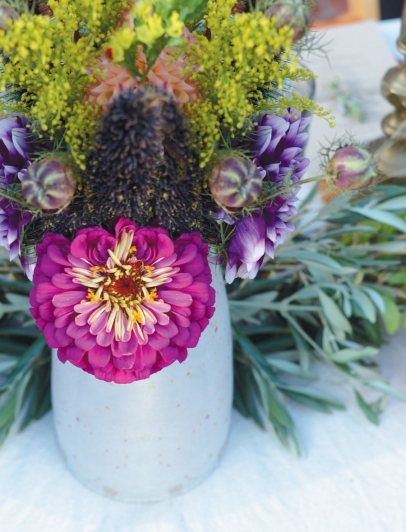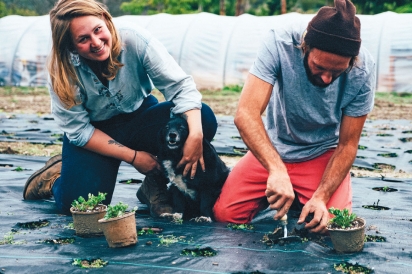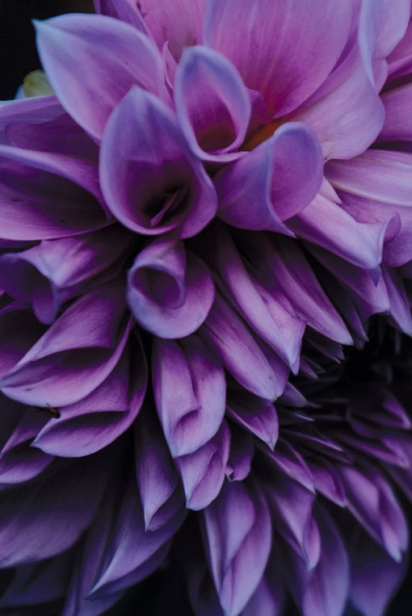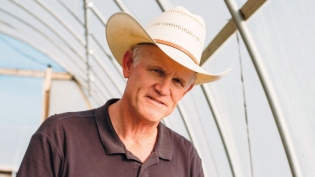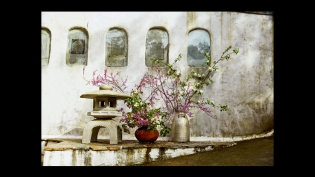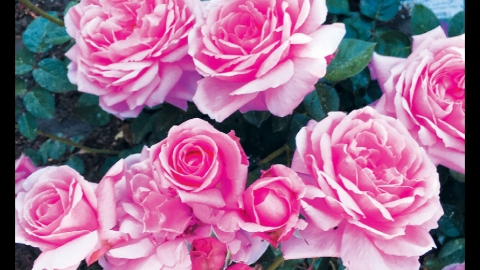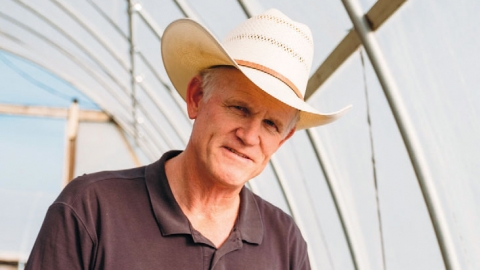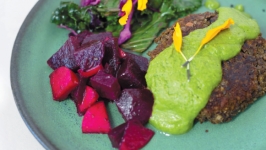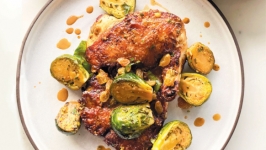From Field to Vase
Going beyond eating local to decorating local
“We have a really cool ecosystem here,” Sean Krumhauer says, surveying the two acres he and partner MacKenzie Curtis were preparing for their spring planting. “Frogs, herons, hawks, a bobcat. The bees thrive in these peppercorn trees.”
A low hum fills the air as they list the many animals that live on or pass through the farm, like the red-winged blackbirds that stopped to feast on their amaranth for several weeks last fall.
Supporting pollinators and other wildlife is merely one benefit of the type of small-scale, sustainable flower farming Curtis and Krumhauer practice to support their Ojai floral design business, TopaFlora.
Flowers are one area that the farm-to-table movement has largely ignored—until now. Locavores who wouldn’t buy supermarket tomatoes in January or Brussels sprouts in July are beginning to understand that buying flowers raised close to home is an important part of supporting local agriculture and reducing the chemical and carbon footprint of the floral industry.
For consumers, buying from local farmer-florists offers a closer relationship to the flowers and greater creative possibilities due to a wider range of not-commonly- imported varieties of flowers.
At TopaFlora, they grow close to 80 different species, with multiple varieties of each flower. They seek out heirlooms, and will grow over 50 varieties of dahlias and five sunflower varieties this year. “The Teddy Bear sunflower is my favorite, if you want something that packs more of a punch,” says Curtis of the latespring bloom.
“I love hearing people say, ‘I didn’t know a sunflower could look like that,’“ Curtis says as she walks to the off-the-grid greenhouse that supplies starts for the farm. “We get to pick a lot of varieties that you wouldn’t find at any flower market or grocery store.”
When a bachelorette party ordered arrangements and leis from TopaFlora, Curtis made the leis from marigolds and succulents. Her wedding bouquets feature a variety of unusual heirloom flowers and textures. She’s also a fan of adding fragrant herbs like dill for an unexpected sensory boost.
Gracielinda Poulson of Grace Rose Farm in Thousand Oaks was born with a love for growing things. “My grandmother always had a really pretty rose garden, and from the time I was a year old, I was playing in the dirt. I’ve always been a gardener.”
When Poulson and her husband were buying a house, they searched for a place she could grow roses on a large scale. She planted about 1,200 rose bushes at their home for the sheer love of them. “I had no idea it could be a business—I wanted to grow them as a passion. Then I realized that I could turn a passion into a business. It’s like a baker thinking, ‘Hmmm. . . maybe someone would buy this recipe.’“
She originally thought to sell her roses at local farmers’ markets, and started an Instagram page to highlight the diverse varieties she grew. Within two weeks, specialty florists were reaching out and asking to buy them. Poulson had stumbled into the wedding industry, where styles were changing rapidly. “Brides are looking for that homegrown look,” Poulson says.
“You used to see brides holding perfectly spherical bouquets, but now brides are looking for the type of bouquet that looks like they were just walking through the English countryside picking flowers. They’re looking for natural, organic, romantic bouquets.”
Despite Poulson’s hesitation around starting a business, she began shipping her roses to designers. “I thought maybe a few florists for Malibu or Ojai weddings would want them, but I’ve shipped roses all over the country. I ship to every state, and they’re all for weddings, or photo shoots promoting weddings.”
“There’s a big movement towards florists wanting to use sustainably grown, seasonal flowers,” Poulson says. “Florists want to source local flowers that aren’t loaded with pesticides and hazardous chemicals. I believe most domestic flower farmers I know try to use organic pesticides and fungicides so as to keep their farm, the soil and beneficial insects that live at their farm as healthy as possible,” she adds.
“By sourcing American-grown flowers, you know there are certain standards in place regarding pesticides, and you don’t mind sticking your nose in the bouquet to smell them.”
Olfactory delight may be the thing that surprises her customers the most. “Greenhouse flowers don’t really have a scent. I get emails from people after we ship them who say that opening the box was like Christmas day. They unwrap the roses, and not only are they aesthetically beautiful, the scent is overwhelming. Every rose has a different scent.”
Poulson recently leased space for 5,000 rose bushes at Tierra Rejada Farm in Moorpark, where she’ll be able to use the farm’s well. “One of the things that has been really challenging with this business is the water issue. I didn’t want to use city water, or even agricultural water, because there are so many people who need it. We only want to grow the business if we can do it sustainably.”
Poulson hopes that more people will take an interest in where their flowers come from. “We try to eat locally because we know the food is healthier. The same goes for flowers.”
To learn more:
Slow Flowers (SlowFlowers.com): Online directory of florists and designers who use American-grown flowers.
Flower Confidential: The Good, the Bad, and the Beautiful by Amy Stewart (Algonquin Books, 2008)


